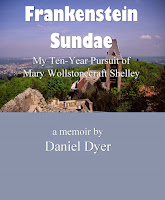Transfusion; or, The Orphans of Unwalden
(1835), William Godwin, Jr.’s posthumous novel, begins in the Swiss village
(fictional) of Unwalden. The narrative camera shows us long and wide shots of the
village, then zooms in to a death-bed scene: It’s the mother of two of our main
characters, Madeline and Albert Schvolen. Albert (who’s deaf) runs out to find
his sister—but can’t—and when he returns, he finds a strange man kneeling
beside the bed. Albert hears his mother call the man “Henry”—and ask him to
care for her children. So … Godwin explains the title early: We know who the “orphans
of Unwalden” are.
Later, a
young man—Wahrend—tries to court Madeline, but she’s reluctant, wary. Then a
letter comes, explaining the children’s mysterious biography. They go looking
for an uncle, who has left Unwalden without notifying them, and so the mystery
unwinds.
There’s some
supernatural stuff going on, too. Albert, it seems, has learned the power of “transfusion,”
the ability to exchange minds with another. At one point he speaks about it to
Madeline: “. . . the great mystery I have
buried deep in my breast, enables me to transfuse one man’s mind into another’s
receptacle for that undefined and immaterial essence.”[1] (172). Near the end, his sister is
dying, and Albert desperately tries to apply this skill to save her. But the
novel ends in great darkness.
Godwin, Jr.
had some talent. Every now and then he pops up out of the narrative for a
comment. There are two sorts of love,
he writes. One—pure, exquisite, and
lovely; founded on affection for a single and invaluable object, and resting
its whole hope on that object’s happiness; the other is single and insidious,
built only on self-gratification and the desire of indulging at all hazards and
unsharing principle.[2]
So we have to
agree with William Godwin that if his son (only 29 when he died, remember) had
survived the cholera epidemic, he might have had quite a literary future.


No comments:
Post a Comment